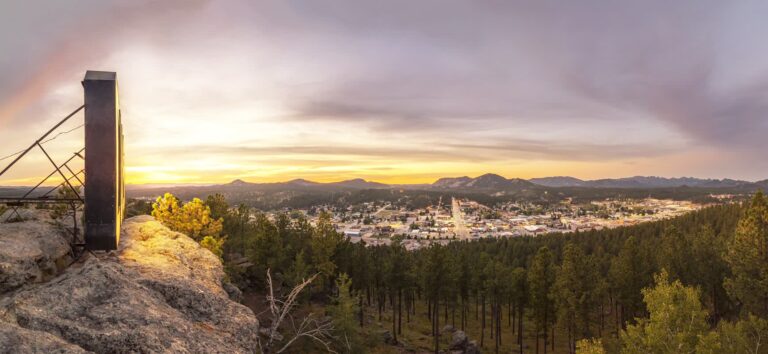When Lieutenant Colonel George Armstrong Custer set out from Fort Abraham Lincoln (present-day Bismarck, North Dakota) in 1874 with over 1,000 men from the 7th Cavalry in tow, his mission was to find a location for a fort, search for a southwest passage, and look for gold. Known as the Black Hills Expedition, Custer and his unit arrived on July 22, 1874, and established a camp where the town stands today. Gold was discovered in French Creek, and the expedition sent word by courier to Fort Laramie, Wyoming. This marked the beginning of the Black Hills Gold Rush.
Despite the Treaty of Fort Laramie, an agreement between the U.S. and the Sioux Indians forged in 1868 that set aside the Black Hills for exclusive use by the Sioux, the allure of gold was too strong to resist and white settlers established the first town in the Black Hills where Custer and his men had made their discovery. A vote was held to decide the name; Civil War veterans from the Union Army wanted to pay respect to Custer, while Confederate Army veterans were partial to Stonewall in honor of Stonewall Jackson. Union veterans outnumbered Confederates, and on August 10, 1875, the town of Custer was born. It is the oldest town established town in the Black Hills.
Custer enjoyed an initial mining boom, but pickings were slim and prospectors began spreading out to other areas in the Black Hills. When placer gold was discovered in Deadwood Gulch in the spring of 1876, most of the miners left Custer for the Northern Hills. A subsequent rich vein in what is now Lead prompted a further exodus, and Custer’s population decreased significantly. Settlers began returning in 1877 once the Sioux gave up their stake in the Black Hills and the area was opened for settlement. Early lawlessness prompted the formation of the Custer County Sheriff’s Office in April of that year.
Development accelerated in 1890 with the arrival of the Chicago, Burlington & Quincy Railroad. The Harney National Forest Headquarters was established in 1898, paving the way for Custer State Park—an expansive 71,000-acre nature and wildlife reserve—in 1913. The city’s first telephone lines were connected in 1915 and regular electricity began flowing in the 1920s. When Korczak Ziolkowski began work on Crazy Horse Memorial on a mountain just north of Custer in 1948, the city’s future as a tourist destination was assured.
Today, Custer is recognized as one of the most beautiful areas in the Black Hills. Its proximity to many of the region’s most popular attractions, a quaint downtown with a thriving food scene, abundant lodging options, and popular events like Gold Discovery Days make Custer a favorite of visitors and locals alike.
Learn More
For more information on attractions and events in Custer, visit us here.

